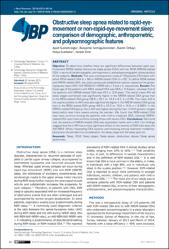| dc.contributor.author | Sunnetçioğlu, Aysel | |
| dc.contributor.author | Sertoğullarından, Bünyamin | |
| dc.contributor.author | Özbay, Bülent | |
| dc.contributor.author | Günbatar, Hülya | |
| dc.contributor.author | Ekin, Selami | |
| dc.date.accessioned | 2020-11-20T15:03:45Z | |
| dc.date.available | 2020-11-20T15:03:45Z | |
| dc.date.issued | 2016 | |
| dc.identifier.issn | 1806-3713 | |
| dc.identifier.issn | 1806-3756 | |
| dc.identifier.uri | https://doi.org/10.1590/S1806-37562016000000012 | |
| dc.identifier.uri | https://hdl.handle.net/20.500.12809/2777 | |
| dc.description | WOS: 000370912800009 | en_US |
| dc.description | PubMed ID: 26982041 | en_US |
| dc.description.abstract | Objective: To determine whether there are significant differences between rapid-eyemovement
(REM)-related obstructive sleep apnea (OSA) and non-REM (NREM)-related
OSA, in terms of the demographic, anthropometric, and polysomnographic characteristics
of the subjects. Methods: This was a retrospective study of 110 patients (75 males) with
either REM-related OSA (n = 58) or NREM-related OSA (n = 52). To define REM-related
and NREM-related OSA, we used a previously established criterion, based on the apneahypopnea
index (AHI): AHI-REM/AHI-NREM ratio > 2 and ≤ 2, respectively. Results: The
mean age of the patients with REM-related OSA was 49.5 ± 11.9 years, whereas that of
the patients with NREM-related OSA was 49.2 ± 12.6 years. The overall mean AHI (all
sleep stages combined) was significantly higher in the NREM-related OSA group than
in the REM-related OSA group (38.6 ± 28.2 vs. 14.8 ± 9.2; p < 0.05). The mean AHI in
the supine position (s-AHI) was also significantly higher in the NREM-related OSA group
than in the REM-related OSA group (49.0 ± 34.3 vs. 18.8 ± 14.9; p < 0.0001). In the
NREM-related OSA group, the s-AHI was higher among the men. In both groups, oxygen
desaturation was more severe among the women. We found that REM-related OSA
was more common among the patients with mild-to-moderate OSA, whereas NREMrelated
OSA was more common among those with severe OSA. Conclusions: We found
that the severity of NREM-related OSA was associated mainly with s-AHI. Our findings
suggest that the s-AHI has a more significant effect on the severity of OSA than does the
AHI-REM. When interpreting OSA severity and choosing among treatment modalities,
physicians should take into consideration the sleep stage and the sleep posture | en_US |
| dc.item-language.iso | por | en_US |
| dc.publisher | Soc Brasileira Pneumologia Tisiologia | en_US |
| dc.item-rights | info:eu-repo/semantics/openAccess | en_US |
| dc.subject | Sleep | en_US |
| dc.title | Obstructive sleep apnea related to rapid eye movement or non-rapid eye movement sleep: comparison of demographic, anthropometric and polysomnographic features | en_US |
| dc.item-type | article | en_US |
| dc.contributor.department | MÜ, Eğitim ve Araştırma Hastanesi | en_US |
| dc.identifier.doi | 10.1590/S1806-37562016000000012 | |
| dc.identifier.volume | 42 | en_US |
| dc.identifier.issue | 1 | en_US |
| dc.identifier.startpage | 48 | en_US |
| dc.identifier.endpage | 54 | en_US |
| dc.relation.journal | Jornal Brasileiro de Pneumologia | en_US |
| dc.relation.publicationcategory | Makale - Uluslararası Hakemli Dergi - Kurum Öğretim Elemanı | en_US |


















